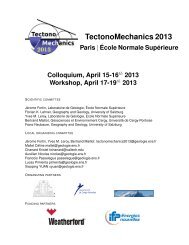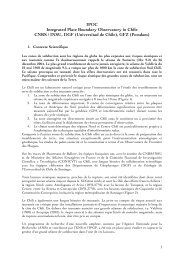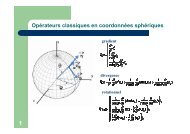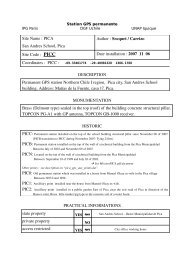PDF file - Laboratoire de Géologie de l'Ecole normale supérieure - Ens
PDF file - Laboratoire de Géologie de l'Ecole normale supérieure - Ens
PDF file - Laboratoire de Géologie de l'Ecole normale supérieure - Ens
Create successful ePaper yourself
Turn your PDF publications into a flip-book with our unique Google optimized e-Paper software.
of them (KIZI, GAZI and KRCD) close to the Bitlis<br />
suture zone and East Anatolian fault (EAF). Although<br />
they argue that the sites are far enough from the main<br />
faults to be outsi<strong>de</strong> the elastic strain field, using these<br />
stations is disputable because of the shortening that<br />
may occur further south within the Arabian plate, in the<br />
Palmyri<strong>de</strong> fold-and-thrust belt.<br />
A significant improvement of the kinematic<br />
constraints on the geo<strong>de</strong>tic motion of Arabia comes<br />
from a regional survey performed in Iran and northern<br />
Oman [Nilforoushan et al., 2003; Vernant et al., 2004].<br />
Among the 27 GPS sites measured, three (KHAS,<br />
KHOS and MUSC) are well within the Arabia plate,<br />
away enough from the plate boundary, and were used<br />
by Vernant et al. [2004], together with BAHR and the<br />
three stations of McClusky et al. [2003] mentioned<br />
above, to <strong>de</strong>rive parameters of rotation for Arabia. We<br />
shall discuss their results in comparison with those<br />
presented in this paper, in which we use an improved<br />
and larger dataset, including four new sites in Yemen<br />
and several sites in Djibouti and Ethiopia, to assess the<br />
motion of Arabia with respect to neighboring plates<br />
GPS data set and processing<br />
In November 1991 the first observations of a 30<br />
points GPS network were ma<strong>de</strong> in the junction zone of<br />
the Somalian, Arabian and African plates around the<br />
Afar region [Ruegg et al., 1993, Walpersdorf et al.,<br />
1997]. During the following <strong>de</strong>ca<strong>de</strong>, many of those<br />
points were remeasured periodically, including a<br />
remeasurement of 4 points in Yemen in 2001.<br />
Campaigns conducted in the framework of a French-<br />
Iranian program provi<strong>de</strong> data on points located in<br />
Oman and southern Iran in 1999 and 2001<br />
[Nilforoushan et al., 2003; Vernant et al., 2004]. Data<br />
from the 12 Iranian sites of the Asia-Pacific Regional<br />
Geo<strong>de</strong>tic Project (APRGP) (1997-2001) are inclu<strong>de</strong>d.<br />
Occasional measurement on La Réunion island were<br />
also used. As many as 42 stations from the<br />
International GPS Service for Geodynamics (IGS)<br />
network [Neilan et al., 1995], spanning six plates<br />
(Eurasia, Anatolia, India, Africa, Somalia, and Arabia)<br />
are inclu<strong>de</strong>d in the processing. This allows not only to<br />
improve the spatial coverage where campaign data are<br />
scarse, but also allows to “tie” the different networks to<br />
each other. The actual number of stations used in each<br />
campaign analysis is shown in Table 1.<br />
We analyze our GPS observations with the<br />
GAMIT/GLOBK software [King and Bock, 1999,<br />
Herring, 1999]. Twenty-four hours measurement<br />
sessions are reduced to daily positions using the LC<br />
Ionosphere free combination and fixing the ambiguities<br />
to integer values when possible We used precise orbits<br />
from the IGS [Beutler et al., 1993], except for the 1991<br />
and 1993 campaigns for which we adjusted global<br />
orbits provi<strong>de</strong>d by Scripps Institution of Oceanography<br />
(SIO). We also used IGS tables for mo<strong>de</strong>lling of<br />
antenna phase centre variations. We do not use<br />
VIGNY ET AL.: ARABIA PLATE MOTION<br />
2<br />
externally <strong>de</strong>termined meteorological data but rather use<br />
the data themselves to estimate tropospheric <strong>de</strong>lay<br />
parameters (once every 3 hours). More <strong>de</strong>tailed<br />
explanations concerning the ol<strong>de</strong>r data set processing<br />
(1991 to 1995) can be found in Walpersdorf et al.<br />
[1999]. For most regional scale baselines, length<br />
repeatabilities (i.e. root-mean-square dispersion of<br />
baselines length about their mean value) steadily<br />
improve from around 10 mm in 1991, to standard values<br />
of around 1 to 3 mm since 1997.<br />
Solutions in a consistent reference frame were<br />
obtained at all epochs by including data from as many<br />
IGS permanent stations available around our study area<br />
at the time of the campaigns. This list increased from<br />
the small number of 4 stations in 1991 to 42 in 2003 and<br />
inclu<strong>de</strong> 16 stations in Europe and central Asia (BRUS,<br />
GRAZ, JOZE, KIT3, MADR, MATE, METS, NOTO,<br />
ONSA, POL2, POLV, SOFI, USUD, WSRT, WTZR,<br />
ZECK), 12 stations in and around Africa (GOUG,<br />
HARK, LAMP, MALI, MAS1, MBAR, MSKU,<br />
NKLG, RABT, SUTH, TGCV, YKRO), 9 stations in<br />
the Middle East (AMMN, ANKR, BAHR, DRAG,<br />
DYR2, NICO, NSSP, RAMO, TRAB) and 5 stations<br />
spread in the Indian Ocean (DGAR, IISC, MALD,<br />
REUN, SEY1). These daily data were combined with<br />
the daily global GAMIT solutions from SCRIPPS IGS<br />
centre (including more than 200 stations spread all over<br />
the world) into a loose system using Helmert type<br />
transformations in which translation, rotation, scale and<br />
Earth orientation parameters (polar motion and rotation)<br />
are estimated. The reference frame is then <strong>de</strong>fined by<br />
minimizing, in the least-square sense, the <strong>de</strong>parture<br />
from a priori values based on the International<br />
Terrestrial Reference Frame (ITRF) 2000 [Altamimi et<br />
al., 2002], of the positions and velocities of a set of 22<br />
well <strong>de</strong>termined stations in and around our study area<br />
(Ankara (ANKR), Ekaterinburg (ARTU), Bahrein<br />
(BAHR), Bruxelles (BRUS), DiegoGarcia (DGAR), Kiev<br />
(GLSV), Gough Island (GOUG), Graz (GRAZ),<br />
Hartebeesthoek (HARK), Bangalore (IISC), Jozefoslaw<br />
(JOZE), Kittab (KIT3), Malindi (MALI), MasPalomas<br />
(MAS1), Matera (MATE), Metsohavi (METS), Onsala<br />
(ONSA), Bishkek (POL2), Mitzpe Ramon (RAMO),<br />
Sutherland (SUTH), Westerboork (WSRT), and Wetzell<br />
(WTZR)). The total misfit to those fiducial stations is<br />
2.8 mm for positions (after rejection of IISC and MALI)<br />
and 1.6 mm/yr for velocities. Such small values indicate<br />
that local velocities are consistently computed in a<br />
stable reference frame.<br />
It is long recognized that without adding a proper<br />
noise mo<strong>de</strong>l to GPS data processing we obtain<br />
unrealistic very low uncertainties on rates <strong>de</strong>termined<br />
over long periods of time. In other words, because we<br />
use many epochs the straight line which fits station<br />
positions at different epochs is <strong>de</strong>termined with a very<br />
low uncertainty, but very commonly does not intersect<br />
these epoch positions with their formal uncertainties.<br />
This does not mean that the rate inferred from the time






